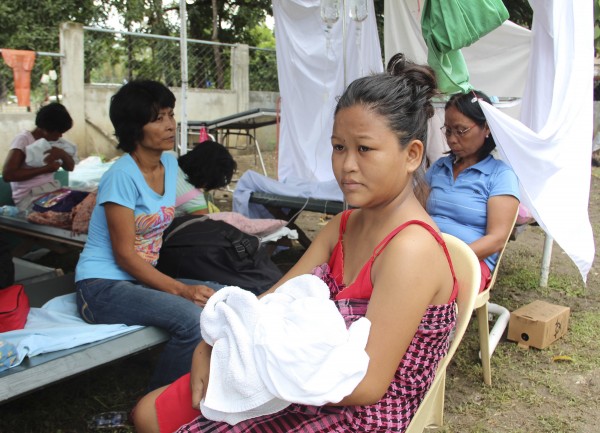Giving birth in Philippine quake – ‘Push and pray’

Earthquake survivor Eileen Rose Carabana cradles her two-day-old baby, James Lyndon, outside a hospital in Calape town, Bohol province, central Philippines on Thursday Oct. 17, 2013. Carabana was one of five young mothers who delivered in Calape town since the 7.2 magnitude quake hit Bohol Island, killing more than a hundred people, destroying hundreds of homes and a dozen or more centuries-old chuches. Eleven hospitals were damaged. AP
CALAPE, Philippines — Eileen Rose Carabana and her mother were in their mountain village house when the 7.2-magnitude earthquake struck the central Philippine island of Bohol. Moments later, she felt an unmistakable intense pain in her abdomen —Carabana was about to go into labor.
There was no other way to get to a doctor but to hike several kilometers down a mountain to the hospital in Calape, a coastal town devastated by Tuesday’s quake that killed at least 158 people and destroyed hundreds of homes and a dozen or more centuries-old churches.
“I was worried for my baby because I could already feel tummy pain,” the 19-year-old recalled Thursday.
When she made it to the hospital, Carabana found patients had already been evacuated to a tent outside, where a humming generator provided light for emergency procedures.
As she went into labor, Carabana said she felt the ground shaking from aftershocks. “I was very scared and I prayed that I would just have a normal delivery in spite of the tragedy,” she said.
Article continues after this advertisementShe recalled the words of the hospital staff: “Just push and pray, push and pray.”
Article continues after this advertisementLater Tuesday night, she gave birth to healthy, 5.3-pound baby named James Lyndon.
Carabana was one of five young mothers who have delivered in Calape town since the quake hit Bohol Island.
Another expectant mother whose house was destroyed had to walk down a mountain to seek help from her relative before finding a ride to the hospital in Calape, said Meneleo Guibao, a nurse who is also the administrator of the 12-bed municipal hospital in the town.
On the way, along bumpy roads torn open by the quake, the woman’s water burst, he said.
The baby came out not breathing and had to be resuscitated, Guibao said. Both the mother and baby were sent to a larger hospital in the provincial capital Tagbilaran, which was better equipped for emergencies. There was no word about their condition.
“Our theory is that she was trying to stop the baby from coming out because it was difficult traveling to the hospital,” Guibao said.
The three other mothers and their babies were all doing fine and two of them were about to be discharged, he said.
Although not a stranger to disasters in a country that is often buffeted by typhoons, floods and shaken by quakes, Guibao said that delivering babies in a tent amid aftershocks was a first for him.
“I have experience in home delivery, but I have not delivered under this calamity situation,” he said.
Guibao said he worried about his patients, but was grateful for caregivers and volunteers who were aiding him and the rest of the staff.
Calape Mayor Sulpicio Yu said that almost 90 percent of the buildings in his town, with a population of 32,000, were partially or totally damaged. At least five people were killed in Calape.
The hospital did not collapse, Guibao said, but there was no electricity and engineers had to check the building for damage before it was declared safe again.
Altogether eleven hospitals across the region were damaged by the quake, two seriously.
The Health Department said that doctors were waiting for helicopters or boats to transfer 60 patients needing surgery and critical care to Tagbilaran from Loon, the Bohol town near Calape that suffered the most damage with more than 40 dead.
On Thursday, authorities said that rescuers and emergency supplies were getting through to towns had been isolated by the quake and where residents camped out in tents waiting for assistance and to start repairing homes.